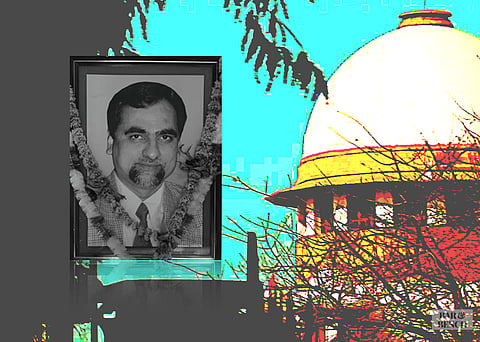
- News
- Columns
- Interviews
- Law Firms
- Apprentice Lawyer
- Legal Jobs
- हिंदी
- ಕನ್ನಡ

In Hans Christian Andersen’s fairytale The Emperor’s New Clothes, it was a child that drew the public’s attention to the fact that the King was indeed naked.
Similar attempts to expose one of the most powerful men in the Indian government were shot down earlier this week by the Supreme Court, which held that the petitions seeking an independent probe into the death of Judge Loya were politically motivated and aimed at bringing disrepute to the judiciary.

When the Emperor puts on these “clothes”, neither his ministers nor his subjects have the conviction to acknowledge that their ruler is in the nude, though they can see it with their own eyes. And despite the child shouting out, “But he hasn’t got anything on,” the public continues to marvel at the Emperor’s non-existent finery, while the ministers hold up the train that was never there.
During the hearings of the case in the Supreme Court, Senior Advocate Mukul Rohatgi, appearing for the state of Maharashtra, argued,
“Either the Court will have to say they [the four judges who insisted Loya’s death was natural] are lying or the petitions have to be dismissed.”
And in the judgment delivered by Justice DY Chandrachud, the Supreme Court chose to stand by the testimony of the four judges who were in proximity to Judge Loya around the time of his death. In their testimonies, Loya’s peers ruled out foul play in the judge’s death in December 2014, despite discrepancies being brought to light by the deceased judge’s family and the media.
Truth be told, the allegations of foul play surrounding the death of a judge hearing the Sohrabuddin case in which Amit Shah was the prime accused are not as stark as the Emperor’s lack of clothes. But the fact remains that there are certain aspects that deserve a second look – the transfer of the judge previously hearing the case, the mysterious chain of events that led to Loya being declared dead, the claims of the family, the alleged manipulation of the post-mortem that came to light after the Court reserved its judgment on March 16.
That this government or any other since time immemorial will not think twice about showing off (or in this case, covering things up) is trite knowledge; the Emperor’s clothes have become weathered with age. Andersen’s story in itself was a piece of political satire aimed at the then King’s court in Denmark.
And like Andersen, the Supreme Court has over the years, criticised the acts and omissions of the government.
But then again, it hasn’t, even when the government flouts its orders. A classic example was seen in the Aadhaar matter, where the government has been on an aggressive drive to implement the scheme mandatorily, even though the Supreme Court ordered otherwise back in 2015.
And speaking of its own orders being flouted, one has to bear in mind that the Sohrabuddin case was listed before three different judges (including Loya), even though the Court had directed that the trial be conducted from the beginning to the end by the same officer. In today’s judgment, the Court chose not to address this issue, stating,
“The issue as to whether Judge JT Utpat could have been transferred has no bearing on the circumstances in which Judge Loya died.”
At a time when sitting judges of the Supreme Court themselves speak about Executive interference in the functioning of the judiciary, it becomes all the more necessary to view with a magnifying glass any instances where the two organs of state are involved, as is the case in the Judge Loya matter.
Ever since the Judges Press Conference (and even before that), the image of the great institution of the judiciary has taken a severe beating. In this light, it becomes paramount for the judiciary to lay bare any attacks against it, and let the truth be the ultimate judge.
However, what the Court held was quite the contrary. In a nutshell, they have held that there are questions against the judiciary, and with a view to protecting the judiciary, they will not entertain those questions.
What harm could a call for an independent investigation have done? If there was nothing to the case, as the government contended, and the investigative team gave a clean chit, would not the stock of the judiciary truly rise in the eyes and minds of the people? Would that also not restore the credibility of the polity? And if the allegations were proven true, the judiciary would have been lauded all the same. The Supreme Court has refused to play in a win-win situation.
For now, all we can do is ponder, even as the “children” point out repeatedly that the Emperor has no clothes.
Alison Prince, in her book Hans Christian Andersen: The Fan Dancer, claims that Andersen received a ruby and a diamond ring from the King after writing The Emperor’s New Clothes and The Swineherd, another work of satire mocking the King’s court. After that, she says, Andersen did not write another work aimed at poking fun at the King.